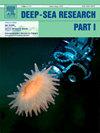Trophic ecology of the deep-sea skate Dipturus oxyrinchus (Linnaeus, 1758) in the bathyal food web of the central Mediterranean Sea
IF 2.1
3区 地球科学
Q2 OCEANOGRAPHY
Deep-Sea Research Part I-Oceanographic Research Papers
Pub Date : 2025-10-04
DOI:10.1016/j.dsr.2025.104602
引用次数: 0
Abstract
The Mediterranean Sea is a biodiversity hotspot where most elasmobranchs are severely threatened, and there is limited knowledge regarding life history traits and trophic ecology. In this context, our study focuses on the trophic ecology of the longnose skate (Dipturus oxyrinchus) in the Strait of Sicily (central Mediterranean), which is designated as an Important Shark and Ray Area. The objectives of the present study were to investigate the main changes in the feeding habits of the species according to ontogeny and bathymetric distribution. We collected 152 specimens at depths between 200 and 700 m from 2016 to 2019. The combination of stomach content and stable isotope analyses allowed to classify the longnose skate as a generalist feeder, with a diet dominated by crustaceans, and smaller contributions of bony fish and cephalopods. The most consumed crustaceans were decapods (including Parapenaeus longirostris, Iridonida speciosa, Chlorotocus crassicornis) and mysids (Lophogaster typicus). Multivariate analyses indicated that predator total length and collection depth had a significant effect on the prey consumption patterns, which was corroborated by General Additive Models (GAM), allowing determination of the most commonly consumed prey. Significant ontogenetic changes were observed, with smaller individuals primarily preying upon benthic organisms and larger individuals adopting a more benthopelagic diet, reflected by a slight increase in trophic position. This study highlights the role of the longnose skate within the bathyal food web of the Strait of Sicily, providing useful information for ecosystem modelling, which will support effective conservation strategies.

地中海中部深海食物网中深海冰鱼Dipturus oxyrinchus (Linnaeus, 1758)的营养生态学
地中海是一个生物多样性的热点地区,大多数板鳃动物受到严重威胁,但对其生活史特征和营养生态学的认识有限。在此背景下,我们的研究重点是长鼻鳐(Dipturus oxyrinchus)在西西里岛海峡(地中海中部)的营养生态学,该海峡被指定为鲨鱼和鳐鱼的重要区域。本研究的目的是根据个体发育和水深分布,探讨该物种摄食习性的主要变化。2016年至2019年,我们在200至700米的深度收集了152个标本。结合胃内容物和稳定同位素分析,可以将长鼻鳐归类为一种多面手的捕食者,以甲壳类动物为主,硬骨鱼和头足类动物的贡献较小。食用最多的甲壳类动物是十足类(包括长尾拟虾、绿齿虾、长角绿齿虾)和粘虫类(典型Lophogaster typicus)。多变量分析表明,捕食者的总长度和采集深度对猎物的消费模式有显著影响,并通过通用加性模型(GAM)证实了这一点,从而确定了最常消耗的猎物。观察到显著的个体发生变化,较小的个体主要捕食底栖生物,而较大的个体采用更底栖的饮食,这反映在营养地位的轻微增加上。这项研究强调了长鼻鳐在西西里岛海峡深海食物网中的作用,为生态系统建模提供了有用的信息,这将支持有效的保护策略。
本文章由计算机程序翻译,如有差异,请以英文原文为准。
求助全文
约1分钟内获得全文
求助全文
来源期刊
CiteScore
4.60
自引率
4.20%
发文量
144
审稿时长
18.3 weeks
期刊介绍:
Deep-Sea Research Part I: Oceanographic Research Papers is devoted to the publication of the results of original scientific research, including theoretical work of evident oceanographic applicability; and the solution of instrumental or methodological problems with evidence of successful use. The journal is distinguished by its interdisciplinary nature and its breadth, covering the geological, physical, chemical and biological aspects of the ocean and its boundaries with the sea floor and the atmosphere. In addition to regular "Research Papers" and "Instruments and Methods" papers, briefer communications may be published as "Notes". Supplemental matter, such as extensive data tables or graphs and multimedia content, may be published as electronic appendices.

 求助内容:
求助内容: 应助结果提醒方式:
应助结果提醒方式:


